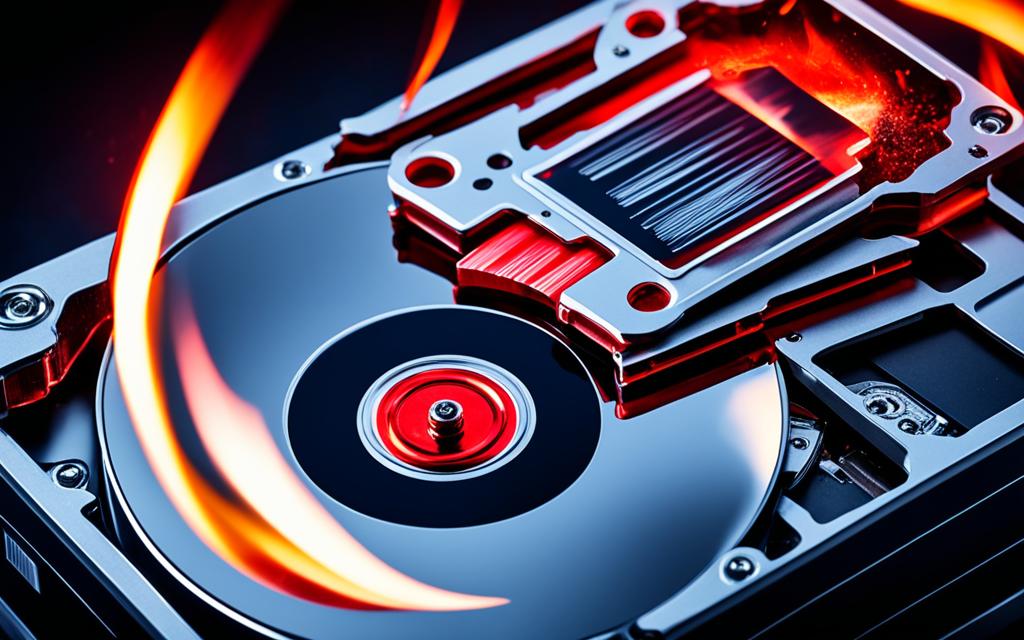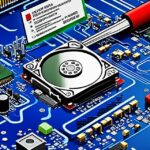Table of Contents
In today’s world, keeping your data safe is very important. Many people think that simply deleting files means they’re gone forever. Yet, this simple method does not fully remove the data.
This can leave your information at risk, as recovery software might bring it back. To truly keep your files private, you must use stronger methods that ensure total deletion.
In our digital age, knowing how to wipe your data matters a lot. This is true whether you’re cleaning up space or selling your device. Using the right wiping techniques is vital. It prevents others from seeing your personal data.
It’s wise to take steps to permanently delete files. Doing so protects your privacy and makes your device work better.
Key Takeaways
- Permanently deleting files is critical for maintaining data security.
- Simple deletion methods often leave data recoverable.
- Third-party software tools can effectively wipe files.
- Physical drives handle deleted files differently; SSDs erase while HDDs retain remnants.
- Overwriting sensitive data can help ensure complete deletion.
- Regular maintenance contributes to better data management.
- Secure deletion practices are essential before disposing of or selling devices.
The Importance of Permanently Deleting Files
In the digital world, keeping your data safe is vital. The danger of someone getting your data from deleted files is real. It’s important to know what happens to files when you delete them. This helps keep your personal info secure and prevents unwanted data leaks.
The Risks of Regular Deletion
Most people think that when they delete a file, it’s gone for good. Sadly, over 85% of people are wrong about this, making them open to data recovery risks if their devices are compromised3. Many believe that clearing the Recycle Bin means their files are completely deleted. Almost 75% of users think this way3. But the truth is, regular deletion doesn’t fully remove files. They can still be retrieved until new data overwrites them3. This situation leaves sensitive data at risk of theft, giving hackers a chance to sneak in.
Benefits of Complete Deletion
Securely deleting files brings several advantages. It not only clears up space but also boosts your device’s speed and safety4. By properly wiping files, you make sure they can’t be reached by hackers. Using file shredders or special deletion software ensures your private info stays private5. This method increases your digital protection, keeping your data locked away from prying eyes.
Methods to Permanently Delete Files
For users wanting to make sure their deleted files can’t be recovered, there are several methods. These can help keep your digital space clean and protect your private info.
Using Software Tools
File deletion software is great for getting rid of files for good. Programs like Avast Data Shredder are perfect for deleting sensitive stuff, like your credit card details. They work by overwriting spaces on your disk with random data. This makes it super hard for anyone to get back what you’ve deleted. Users find these tools very reliable for removing data they no longer want.
Keyboard Shortcuts and Right-click Menus
Keyboard shortcuts can make deleting files faster and more secure. Pressing Shift + Delete deletes files right away, skipping the Recycle Bin6. Or, you can right-click a file and choose “Delete” for an easy option. Remember, this usually just sends files to the Recycle Bin. You need to use keyboard shortcuts to delete them for good6. Both methods are good for keeping your sensitive information safe.
How to Delete Files Completely from Hard Drive
To make sure sensitive data is gone for good, knowing how to delete files on Windows is crucial. You need to select the right method for the kind of storage you have, like SSDs or HDDs. This guide will help you erase data effectively.
Step-by-Step Guide for Windows Users
Deleting files in Windows can be simple. You might think just right-clicking and choosing “Delete” does the job. However, this leaves the data open to recovery. For true security, follow these steps:
- Pick the files you need to erase.
- Use strong software like BCWipe for the wiping process, making sure files and their data are gone for good7.
- Check and tweak your wiping settings in BCWipe as needed.
- Hit “Yes” to start the wipe and ensure everything is removed7.
If you’re looking into recovery, wiping free space is a good two-step strategy. It helps clear out files that are no longer needed but still present7.
Special Instructions for SSDs vs HDDs
SSDs and HDDs delete data differently. SSDs need special tools and settings to make sure you can’t get the data back. Using the TRIM command is key for SSDs to handle data better and delete files properly7. HDDs work well with simple overwriting. But SSDs require both wiping and the TRIM function for full deletion. Below, see the comparison of methods for these storage types:
| Storage Type | Deletion Method | Data Recovery Status |
|---|---|---|
| HDD | Wipe files, use clean commands via CMD | Data may still be recoverable if not properly wiped |
| SSD | Wipe files + use TRIM function | Difficulty in recovery due to immediate deletion |
| Both | Utilise data wiping software | Effectiveness depends on method chosen |
Just clicking delete doesn’t fully remove files, leaving sensitive info at risk8. By following this guide, you can manage and secure your data better.
Best Practices for Data Security
Data security includes many strategies to keep information safe. Regular maintenance and cleaning of hard drives are key. They ensure systems work well and lower the chance of data being stolen.
Regular Maintenance and Cleanup
Setting a maintenance schedule not only boosts system performance but also keeps data secure. Cleaning out old files stops them from piling up. Tools for secure file deletion protect private information. BitRecover BitWipe is great for deleting chats and browser histories, meeting top security standards9.
Considerations Before Selling or Disposing of Your Hard Drive
Before you sell or throw away a hard drive, securely deleting data is a must. If not done right, personal data could be accessed by others, risking your security10. Using Heidi Eraser for Windows or options for Mac makes sure no one can recover your data. It’s vital when you’re passing it on11. Keeping your asset list updated and following disposal policies are crucial steps10.
| Stages of Data Security Practices | Actions | Tools |
|---|---|---|
| Regular Maintenance | Clean up unnecessary files | Data optimisation tools |
| Secure Data Deletion | Wipe data clean before disposal | Heidi Eraser, Built-in Mac tools |
| Data Inventory Management | Update lists and manage devices | Inventory management software |
| Compliance Checks | Ensure adherence to data policies | Security policy frameworks |
Conclusion
In today’s digital world, the importance of safely deleting files is more clear than ever. With so many risks to our data, this guide has shown the big difference between just deleting and making sure files are gone for good. Using the right tools, like BitRaser File Eraser, makes sure your files can’t be found again, helping keep your information safe.
Learning how to correctly delete files forever helps avoid the risk of them being found. By using techniques such as partition formatting and the Wipe Disk feature, you can protect your data12. This not only helps your system run better but also keeps you calm knowing your personal data is safe, especially when you’re getting rid of old devices13.
If you want to know more about securely wiping files, there are guides that explain everything. It’s really important to use these methods to create a safer digital space. Your information stays secure and your privacy is a top priority. For more help, check out this guide on how to permanently delete files14
FAQ
What is the difference between deleting and permanently deleting files?
When you delete files, they go to the Recycle Bin. You can get them back if needed. Permanently deleting files, however, makes sure they can’t be recovered. This keeps your data safe and private.
Why is secure file deletion important?
Secure file deletion stops unwanted access to your important info. Regular deleting leaves data bits that can be retrieved. This could make your private details vulnerable to breaches.
What tools can I use for secure file deletion?
Tools such as BCWipe and CCleaner are good for getting rid of files for good. They overwrite data so it can’t be brought back, which keeps your private info safe.
How can I permanently delete files on a Windows computer?
To delete files forever on Windows, use Shift + Delete or choose “Delete” with a right-click. Don’t forget to clear the Recycle Bin to ensure those files are gone for good.
Are there different methods for deleting files on SSDs compared to HDDs?
Yes, SSDs remove files straight away, making them tough to retrieve. For SSDs, use TRIM-enabled tools. HDDs, though, need data to be overwritten for secure removal.
How can regular maintenance improve data security?
Regularly cleaning up your files helps keep your system tidy and running well. It also securely gets rid of any sensitive content, lowering your risk of data leaks.
What should I do before selling or disposing of a hard drive?
It’s key to completely erase all data from a hard drive before you sell or throw it away. This stops anyone from getting their hands on your personal info.
Source Links
- https://www.avg.com/en/signal/delete-files-windows – How to Permanently Delete Files From Windows
- https://www.pcworld.com/article/504414/how_do_i_permanently_delete_files_from_my_hard_disk.html – How Do I Permanently Delete Files From My Hard Disk?
- https://www.easyfileshredder.com/how-to-permanently-delete-files-on-windows.php – Easy File Shredder – Securely Delete Files from Windows PC
- https://www.stellarinfo.com/blog/how-do-i-permanently-delete-files-from-my-external-hard-drive/ – How to Permanently Delete Files from External Hard drive?
- https://www.aptosolutions.com/blog/when-does-deleting-a-file-not-delete-it – When does deleting a file not delete it? – Apto Solutions
- https://www.avast.com/c-permanently-delete-files – How to Permanently and Securely Delete Files on Windows 10
- https://www.jetico.com/blog/how-wipe-deleted-files-your-hard-drive – How to Wipe Deleted Files from Your Hard Drive
- https://www.diskgenius.com/resource/permanently-delete-files.html – How to Permanently Delete Files from Computer Hard Drives in Windows 10/11?
- https://www.linkedin.com/pulse/how-erase-data-permanently-from-hard-disk-complete-guide-jamie-kaler-b5eoc – How to Erase Data Permanently from Hard Disk- Complete Guide
- https://kirkpatrickprice.com/blog/secure-data-destruction-guide/ – Secure Data Disposal and Destruction: 6 Methods to Follow
- https://safecomputing.umich.edu/protect-yourself/prepare-devices-disposal/securely-delete-files – Securely Delete Files / safecomputing.umich.edu
- https://www.partitionwizard.com/partitionmanager/how-to-permanently-delete-files.html – How to Permanently Delete Files on Windows 11/10? 6 Ways
- https://www.diskpart.com/articles/how-to-permanently-delete-files-from-hard-drive-windows-xp-1503.html – How to Permanently Delete Files from Hard Drive Windows XP?
- https://www.stellarinfo.co.in/blog/how-to-permanently-delete-files-from-hard-drive/ – [Solution]: How to Permanently Delete Files from Hard Drive?








